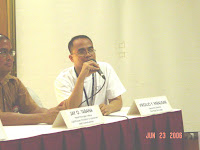Combining the very best of the not-for-profit, philanthropic world with the very best of the for-profit, enterprising world...
The Current Situation
Billions of private funds have been poured, directly or indirectly into the public school system to improve the quality of education. Yet, the deterioration continues.
The state of Philippine education is bleak. Official statistics from the Department of Education reveals that 9.2 million out of 57.6 million Filipinos aged 10 to 64 years cannot read, write, subtract and add, or understand simple instructions.
Our answer: SOCIAL ENTREPRENEURS
They are Generative Leaders who combine savvy with social mission. They are P.E.A.R.L.S.: Passionate, Ethical, Action-oriented, Results-focused, Leaders of Society.
They lead, inspire, provide a vision and engage people to create something of themselves, thereby, fundamentally changing communities. Social entrepreneurs are catalysts of change.
Bill Drayton defines a social entrepreneur as someone who recognizes when a part of society is STUCK, and provides new ways to get it UNSTUCK. He finds what is not working and solves the problem by changing the system, spreading the solution and persuading entire societies to take quantum leaps.
Social entrepreneurs, Drayton adds, "are not content just to give a fish or teach how to fish. They will not rest until they have revolutionized the fishing industry."
However, social entrepreneurs are like other entrepreneurs. They look for "irritants" in the environment and convert these into opportunities. They do this mainly as a social mission, with the savvy of "combining the very best of the not-for-profit, philanthropic world with the very best of the for-profit, enterprising world" (Bill Strickland, "Genius at Work"). They pursue their goals with the same fervor and discipline as any true blue entrepreneur.
Our Solution: THINKING OUT-OF-THE-BOX
What if, the not-for-profit and the for-profit organizations work together to address this problem?
The NGOs, POs, cooperatives or individuals can get together to take up the challenge and set up an alternative parallel school system. This concept is called the Pearl Principle Formation School (PPFS) System. PPFS System is established in support of public school but planned, led, organized and coordinated for quality by the people, of the people, for the people. We can begin by establishing a program from Kindergarten until Grade 2.
The Pearl Principle Formation School System
The first 6 years in a child's life, the early childhood stage, is the most crucial because it is within this period that the foundation of one's PERSONHOOD is laid out. The PPFS System offers pre-school education with a strong bias on Reading and Comprehension, Writing, Mathematics and English as a Second Language.
The PPFS System uses a curriculum validated by a system-wide Quality Assurance, known as Global Examinations and Qualifications (GEQ). Designed by curriculum experts from leading private schools, less privileged students are assured of better quality education. It is administered using a curriculum that is consistent with quality standards, and supported by first-rate teacher training offered at a very affordable cost.
The Business Model
Traditional sources of funding are becoming scarce. Donor-fatigue syndrome is mounting because of global recession and economic crisis.
The ultimate goal is to have the parallel school system attain self-sufficiency while increasing its social impact. This is achieved by massively promoting Social Entrepreneurship to operate as many Pearl Principle Formation Schools as possible in urban as well as rural areas.
The main requirement is the passion for social engagement to make a difference in the development of our country. NO LICENSE FEE is required.
The Challenge
How many of us will dare find the gift within ourselves and actually turn it into something positive? How many of us can find and honor our strength and flexibility with the inner power to create and succeed rather than break apart?
Engage with us in this mission - for love of country. Together, let us build a better future for Filipinos through quality education.
WHAT YOU NEED TO HAVE
PPFS Requirement
* Passion for social engagement to make a difference in the development of our country.
* A minimum land area of 200 sq. m. situated in lower middle class communities with provisions for at least 2 classrooms at 45 sq. m. per classroom.
WHAT YOU GET
PPFS Support Package
* Affiliation and support froM established reputable private schools
* High Standard Curriculum
* Quality Assurance from GEQ
* Comprehensive Training Program
* Management consulting support from GEQ
* Standardized Operations Manual
* Assistance in site improvement
* Consulting support on Finance Management
The Pearl Principle is an ideology of positive change. It states that one has to initiate change from within and within one's sphere of influence. It is an advocacy of transforming a state of hopelessness into a state of optimism where opportunities are created as in the creation of a pearl.
Attend the PPFS ORIENTATION on August 12, 2006, 10:00 a.m., at the 10/F Cordova Condominium Valero corner Sedeño Streets, Salcedo Village, Makati City
Call: Manila Telefax (02) 8889999
Direct Line (02) 8923088
Cebu Telefax (032) 2332522
Direct Line (032) 4127633








